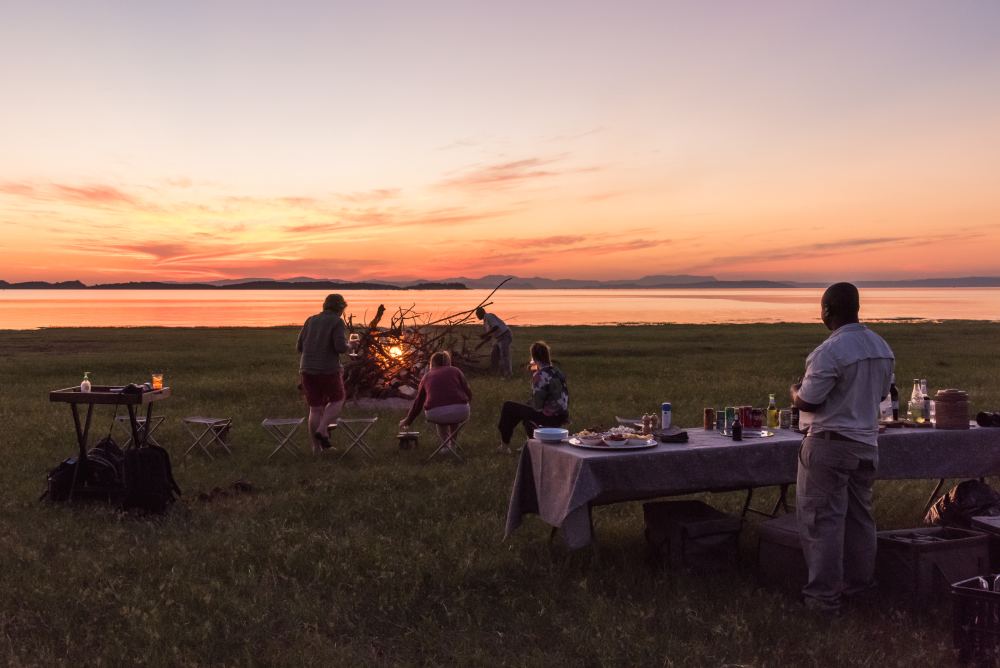Sundown
The sundowner is an African ritual. At the end of a hot dusty day you find a spot to chill out with a beer, share the day’s adventures and admire the setting sun. It comes as a pleasant surprise to a Brit who lives at 54 degrees north. Where I live, the sun sets at mid-afternoon in winter and close to midnight in summer, and it is usually raining. In contrast, sunsets in Africa are predictable, with a large sun slipping beneath the horizon at around 6.30pm every day. The sun sinks quickly with less than half an hour from when you start thinking about photographing the sunset to total darkness. At first the light turns to soft gold, then to red and blue, to gold again if there are cloud reflections. Then the colour drains away before your eyes to leave darkness. If you want to capture a good sunset image you need to act quickly.
The speed of a tropical sunset is extraordinary because the sun drops perpendicular to the horizon. At higher latitudes (where I live) the sun sets obliquely, lingering longer above and below the horizon, creating a much longer twilight.
At the equator (0 degrees latitude) the air is hotter and less dense. The height of the atmosphere at the equator is 17km compared to just 9 km at the poles. These differences in density and height mean the setting sun’s rays are refracted differently making the sun bigger. Furthermore, African landscapes are often wide and empty, with the sun clearly visible against an uncluttered horizon. When the brain sees the sun against the horizon it thinks it is bigger than it really is. This is known as the ‘moon illusion’.
The camera works in a different way to the human eye and brain. The sensor records the light that hits it, whereas our brains adjust what our eyes see, giving the image that is most useful to us, accentuating points of interest and adjusting light and shadow to give us maximum awareness of what is in front of us. This is why views that look great to the eye often appear flat and dull on the camera and animals we thought we saw distinctly often look small and fade into the background. To catch the setting sun you have to compensate for the ‘moon illusion’, using a telephoto lens to compress the perspective and make the sun seem larger; otherwise the image will not be as good as your memory.
Images of the setting sun work best where there is both foreground interest and distant horizon. This image combines the soft purple light after the golden period, a reasonable foreground, and the sun slightly obscured by the undergrowth and a cloud. I am particularly proud of this image, which I took in the Okavango, as the Botswana Tourist Board used it as a backdrop for one of their exhibition stands.
It is surprisingly hard to get a good image of the setting sun. What you really need for a good sunset photograph is foreground interest, some clouds to give reflections and the sky and sun behind. You are not helped by guides taking you to their favourite sundowner spot to admire the vast expanse of open land leading to the sun setting far away on the horizon.
This image, taken in Chobe in Botswana, doesn’t quite come off, partly because there is a tree that merges with one of the giraffe (it wasn’t possible to change the viewpoint) but mainly I think because the sun is simply too bright and stand alone and as a result unbalances the composition. Great for enjoying your beer, but not so good for photography. In such cases, sit back, put the camera away and enjoy the view.
Sometimes you can be lucky and discover an opportunity to be creative. In this image of a cormorant drying its wings, the sun is further below the horizon here, making the reflected colours muted, and the blue of the sky bright.
Unlike Botswana and a lot of Zimbabwe, the vast arid Karoo region of South Africa is mountainous, so it is hard to photograph the setting sun directly, as it is usually disappearing behind a mountain ridge long before it is photogenic. However, because South Africa is further from the equator, twilights are longer, with scope for photographing the sky after the sun has dipped below the horizon. Despite very low rainfall, the Karoo often has a lot of cloud, enhancing the golden skies.







At sundown, photography is about location and composition, not about the camera settings. Use a telephoto to capture the sun itself to make it look large relative to its surroundings, a wide angle for landscapes, and underexpose where necessary to avoid blown highlights. And don’t forget to drink the beer and enjoy the view.